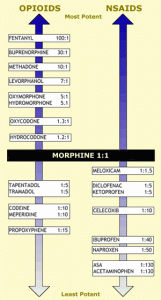 There’s been some discussion lately on the real meaning of the term potency when applied to commonly used drugs. We read about synthetics that are portrayed as 50 or 100 times the strength of morphine, wondering what that means in practice. Here’s a simplified overview.
There’s been some discussion lately on the real meaning of the term potency when applied to commonly used drugs. We read about synthetics that are portrayed as 50 or 100 times the strength of morphine, wondering what that means in practice. Here’s a simplified overview.
Potency is one of three factors that predict the effect of a given drug. It’s a measure of the amount or concentration needed to produce a specific effect– say, in the case of opioids, to suppress pain. The other factors are affinity, the drug’s ability to bind with a particular receptor type, and efficacy, its ability to initiate a response when it does bind. Presumably, a more potent drug produces a greater response at a lower concentration than a less potent variety.
There are so many opiates and opioids out there that for purposes of comparison, their strength is measured in relation to morphine, the principal painkilling component of opium. Hydrocodone (Vicodin, Norco) is rated around 160% as strong as morphine, while oxycodone (Oxycontin) comes in at 1.5 to 2 times as strong as morphine. That simply suggests that a higher dose of Vicodin is required to achieve the same effect as a lower dose of Oxycontin. Other factors are at work as well, so accurate dosing is more complicated in practice.
Heroin, taken intravenously, rates at 2-5 times the strength of morphine, but its half-life is short so effects wear off quickly. By comparison, methadone rates 3-4 times morphine, but has metabolites that extend its half-life to 15-60 hours– a real advantage for use in maintenance therapy, because it requires much less frequent dosing. Some experts argue that when used in maintenance, the accumulation of those metabolites mean that the effects of the methadone are actually 7-8 times morphine. Someone without the elevated tolerance of the addict would overdose.
Fentanyl is generally rated around 80 times morphine (50 times heroin), characterized as extremely fast acting with a brief duration of effect. It’s a major factor in the rising toll of overdose fatalities, both by itself and when found in combination with heroin.
With me so far? All these numbers are open to revision; they’re just what I found in my reference material.
For sheer potency, you can’t beat large animal veterinary meds. Etorphine is the stuff they put on tranquilizer darts used to sedate elephants or rhinoceri. You’ll see that rated from 1000-3000 times morphine. No human could survive it, and I for one am hoping no one is dumb enough to try.










